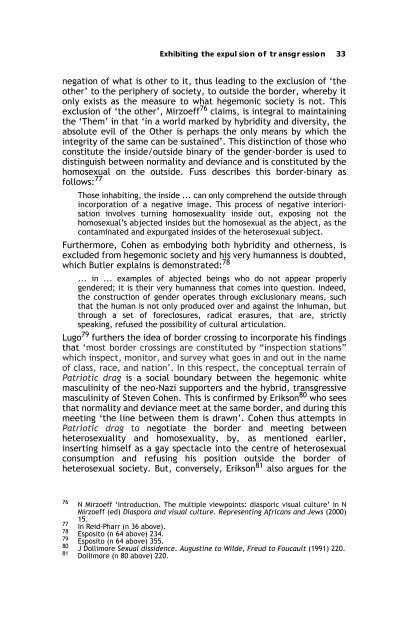Sex, Gender, Becoming - PULP
Sex, Gender, Becoming - PULP
Sex, Gender, Becoming - PULP
Create successful ePaper yourself
Turn your PDF publications into a flip-book with our unique Google optimized e-Paper software.
Exhibiting the expulsion of transgression 33<br />
negation of what is other to it, thus leading to the exclusion of ‘the<br />
other’ to the periphery of society, to outside the border, whereby it<br />
only exists as the measure to what hegemonic society is not. This<br />
exclusion of ‘the other’, Mirzoeff 76 claims, is integral to maintaining<br />
the ‘Them’ in that ‘in a world marked by hybridity and diversity, the<br />
absolute evil of the Other is perhaps the only means by which the<br />
integrity of the same can be sustained’. This distinction of those who<br />
constitute the inside/outside binary of the gender-border is used to<br />
distinguish between normality and deviance and is constituted by the<br />
homosexual on the outside. Fuss describes this border-binary as<br />
follows: 77<br />
Those inhabiting, the inside ... can only comprehend the outside through<br />
incorporation of a negative image. This process of negative interiorisation<br />
involves turning homosexuality inside out, exposing not the<br />
homosexual’s abjected insides but the homosexual as the abject, as the<br />
contaminated and expurgated insides of the heterosexual subject.<br />
Furthermore, Cohen as embodying both hybridity and otherness, is<br />
excluded from hegemonic society and his very humanness is doubted,<br />
which Butler explains is demonstrated: 78<br />
... in ... examples of abjected beings who do not appear properly<br />
gendered; it is their very humanness that comes into question. Indeed,<br />
the construction of gender operates through exclusionary means, such<br />
that the human is not only produced over and against the inhuman, but<br />
through a set of foreclosures, radical erasures, that are, strictly<br />
speaking, refused the possibility of cultural articulation.<br />
Lugo 79 furthers the idea of border crossing to incorporate his findings<br />
that ‘most border crossings are constituted by “inspection stations”<br />
which inspect, monitor, and survey what goes in and out in the name<br />
of class, race, and nation’. In this respect, the conceptual terrain of<br />
Patriotic drag is a social boundary between the hegemonic white<br />
masculinity of the neo-Nazi supporters and the hybrid, transgressive<br />
masculinity of Steven Cohen. This is confirmed by Erikson 80 who sees<br />
that normality and deviance meet at the same border, and during this<br />
meeting ‘the line between them is drawn’. Cohen thus attempts in<br />
Patriotic drag to negotiate the border and meeting between<br />
heterosexuality and homosexuality, by, as mentioned earlier,<br />
inserting himself as a gay spectacle into the centre of heterosexual<br />
consumption and refusing his position outside the border of<br />
heterosexual society. But, conversely, Erikson 81 also argues for the<br />
76<br />
N Mirzoeff ‘Introduction. The multiple viewpoints: diasporic visual culture’ in N<br />
Mirzoeff (ed) Diaspora and visual culture. Representing Africans and Jews (2000)<br />
15.<br />
77<br />
In Reid-Pharr (n 36 above).<br />
78 Esposito (n 64 above) 234.<br />
79 Esposito (n 64 above) 355.<br />
80<br />
J Dollimore <strong>Sex</strong>ual dissidence. Augustine to Wilde, Freud to Foucault (1991) 220.<br />
81 Dollimore (n 80 above) 220.
















